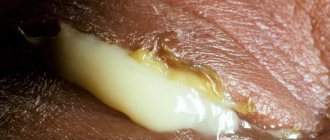One of the most complex and controversial psychiatric diseases of our time is schizophrenia.
Its symptoms are so diverse that only a highly qualified psychiatrist can diagnose the disease. The prerequisites for the disease can appear suddenly and unexpectedly. Therefore, it is necessary to be aware of such a mental disorder and its symptoms. This will allow you to recognize the disease in time and seek help in advance.
General concept
Schizophrenia is a polymorphic disorder characterized by a gradual breakdown of thought processes and emotional reactions. It is one of the most common mental pathologies in modern society, which is progressive in nature. The patient loses normal mental functions: the process of healthy thinking is disrupted, which is accompanied by a gradual decrease in psychological activity.
The systematic development of mental pathology leads to volitional exhaustion, which ends in permanent disability. A schizophrenic is unable to continue active life while in a previously familiar society. Therefore, it is extremely important to detect the problem at the stage of its debut and carry out appropriate therapy that will help stop the disease, minimize its symptoms, and return a healthy, completely adequate person to society.
Diagnostics
According to statistics, the disease manifests itself most often in adolescence. If there are certain triggers, you can feel the disease at a fairly young age. The onset of schizophrenia is usually observed before the age of 30–35 years.
Prussian psychosis
As noted above, the first symptoms of the disease appear at a young age; schizophrenic disorder does not appear in the second half of life. Acute psychosis in elderly patients is classified in psychiatry as “cyanotic psychosis” rather than schizophrenia. However, its symptoms are quite similar to those of schizophrenia. Hallucinations and delusions may occur. But, most likely, they will be of a vascular nature: vascular dementia, brain destruction (Alzheimer’s, Parkinson’s or Pick’s disease). In any case, such organic brain lesions are not related to schizophrenia. Quite often, the differential diagnosis of schizophrenia causes significant difficulties. This is especially true for the initial stage of the disease or periods of deep remission, as well as when one person combines alcoholism and schizophrenia or has suffered psychotrauma against which pathology has developed. Thus, within the framework of the differential method, it is quite difficult to determine the disease on your own. As noted above, not every symptom characterizes this particular disorder. But a person cannot suspect schizophrenia in himself, since this is associated with a loss of criticism.
He may, for example, discover depression or neurosis and, in connection with them, go to a specialist, who, in turn, should conduct a more detailed study and prescribe medication. But, unfortunately, the disease is often noticed by the patient’s relatives at fairly late stages and they are hospitalized in an acute condition, because advanced symptoms are most often interpreted as coincidences or coincidences, or as a consequence of stress or neurosis. Thus, everyone expects that they will go away on their own, and if they take medications, they are more likely of homeopathic or herbal origin, which do not cure the disease, but simply help to prolong it. Thus, due to incorrect diagnosis and late diagnosis, schizophrenic psychosis most often debuts in the patient in an acute form.
Differential diagnosis of the disorder
An important stage of diagnosis is the differentiation of a schizophrenic attack from a neurotic or other mental disorder, as well as the rejection of diseases of an infectious nature that have a destructive effect on neural connections.
For example, an acute psychosis or manic episode, also identified as a polymorphonic psychotic disorder, can also unfold against the background of other diseases, for example, within the framework of schizoaffective or bipolar disorder, which can serve as precursors, but in general are not related to schizophrenia, since they are to another cluster of diseases, a cluster of mood disorders. Bipolar affective disorder, for example, has a more favorable prognosis for life and work. However, even an experienced specialist can sometimes confuse the state of acute psychosis in a neurotic or other disorder with a schizophrenic coat (schizophrenic psychosis). That is why it is very important to observe a person with a team of specialists and in dynamics. The patient’s condition after recovery from acute psychosis is of great importance, since only the stagnation phase makes it possible to more clearly differentiate schizophrenia from other mental disorders.
Types of mental deviation, their features
The schizophrenic process in women can occur in different forms: simple, resistant, paranoid, catatonic, and less commonly, hebephrenic. Each of them has its own characteristics, depending on which the following types are distinguished:
- continuously flowing. Attacks occur regularly and are characterized by varying duration and severity;
- episodic (paroxysmal). This form differs in that the patient may acutely feel only one or several attacks throughout the entire period of the disease. A timely response and regular monitoring by the patient of her condition preserves the effect after therapy for the longest possible time;
- unfavorable. Its peculiarity lies in the high speed of the progressive schizophrenic process. The final mental disorder can occur in the shortest possible period of time;
- sluggish. It is one of the most common forms of mental deviation among the fairer sex, which needs a more detailed description.
Sluggish schizophrenia
One of the most pronounced symptoms of this type of endogenous disease is the woman’s unusual behavior. In this case, one or more additional symptoms may be observed:
- delusional states, which are characterized by a distorted perception of reality - the patient becomes obsessed with persecutors, insists on her “superpowers” or the presence of an incurable disease;
- hallucinations. This is a manifestation of the disease in the form of non-existent voices that only a schizophrenic hears, as well as visions and smells;
- A frequent symptom is a tendency to philosophize. “Inside out” logic in such a patient is capable of creating the most incredible causal and hereditary relationships that have nothing to do with reality. In everything that happens, she begins to see omens, signs or symbols of approaching inevitability;
- loss of self-control. A schizophrenic woman is fully confident that in difficult or unforeseen situations she is unable to control her emotions, movements, speech, and someone does this for her (an otherworldly force, an ill-wisher, a relative);
- increased irritability is activated. Aggression manifests itself in the form of obvious hostility and asociality;
- the person loses interest in everything she previously did, becomes emotionless and withdrawn, and may not go outside for days;
- chronic depression, which is based on the inability to receive emotional pleasure;
- phobias and obsession. Suddenly you feel fear for your life, the life of your children or close relatives.
Ignoring the first signs of female schizophrenia provokes their further development and worsening. As a result, the patient experiences a total flattening of personality: mental sensitivity disappears, the level of social development decreases to primitive.
Schizophrenia symptoms
The signs of the disease are clearly indicated by doctors. All symptoms of schizophrenia are divided into 4 large groups:
- positive;
- negative;
- disorganized;
- affective.
Positive symptoms
Positive signs of schizophrenia were not previously inherent in the patient, are not specific traits of his character, and arise exclusively against the background of the disease. The term “positive” implies the emergence of new qualities, in this case it is not used as “good”. This group of symptoms includes:
- inappropriate reactions to people and events;
- constantly excited state;
- delusions, illusions, hallucinations.
Inappropriate behavior is expressed in the form of stupid actions, excessive nervousness, inconsistency of manners and appearance of a certain situation. This category includes two types of mental disorders - depersonalization and derealization. The first represents a violation of internal boundaries: a person’s personality seems to be split into two parts. One of them performs certain actions, the second watches them and cannot interfere. The body and thoughts seem foreign to a person, as if someone else had settled inside him. This “tenant” dictates his own rules, indicates the need to perform certain actions.
Derealization is characterized by increased perception of various factors (sounds, smells, shades). It seems to a person that everything that happens has no connection with reality, this is a kind of theater in which each “actor” plays his own role.
Catatonia is considered one of the variants of inappropriate behavior in schizophrenia. The person falls into a stupor, takes an awkward position and remains in it for a very long time. Any attempts from the outside to bring him out of this state are doomed to failure. Schizophrenics have great muscle strength and are able to successfully resist.
Hebephrenia is also a type of inappropriate behavior. Regardless of where the patient is, he behaves stupidly, constantly laughs, fools around, jumps on the spot, makes grimaces. Discussions about the inappropriateness of such behavior lead nowhere. Attempts to appeal to conscience end in failure.
Hallucinations are a complex of sensations of a specific nature that do not really exist. They are inextricably linked with the human senses and are divided into gustatory, visual, olfactory, tactile and auditory. In schizophrenia, the patient most often suffers from auditory hallucinations. In the surrounding space or in his own head, he hears voices conducting a coherent conversation with him. They can give commands, which the schizophrenic often obeys, to calm or make people laugh. Hallucinations lead to the development of delusional ideas. A schizophrenic is absolutely sure that everything that happens to him is real, and his loved ones deceive him for an unknown purpose.
Negative symptoms
The category of negative symptoms in schizophrenia characterizes signs that have disappeared or changed their functions. If before the onset of the disease a person’s character had certain traits and qualities, after the manifestation of the disease they either disappear completely or become less pronounced.
This category includes:
- loss of vital energy, motivation to act;
- lack of initiative in everyday and professional matters;
- physical passivity;
- decreased thinking functions, impaired cognitive processes;
- narrowing the range of interests;
- emotional poverty, apathy, indifference to what is happening;
- movements become sluggish and sluggish;
- self-control is weak or absent;
- the patient cannot construct an algorithm of sequential actions;
- he is unable to derive pleasure from external stimuli.
Lack of motivation for everything leads to personality degradation (similar symptoms are observed during the treatment of Pick's disease). Schizophrenics strive for social isolation, they often do not leave the house, and neglect the rules of personal hygiene. Their appearance becomes sloppy, which alienates others. You can understand that a person has schizophrenia by the following features of his speech:
- he constantly jumps from one topic to another, interrupts himself, constructs an incoherent speech;
- uses new, often awkward words that he comes up with;
- repeatedly repeats individual phrases and sentences after others;
- speech becomes rapid and incoherent;
- begins to speak in rhyme;
- answers to questions are monosyllabic, incomplete or unclear;
- in the absence of thoughts, he suddenly withdraws into himself, stopping the conversation.
Often in schizophrenics, thinking disorder is expressed in reasoning. A person constantly talks about topics he has come up with, even if they try to involve him in another conversation or interrupt him, he does not react to this.
Disorganized symptoms present difficulties with spatial orientation. These include chaotic behavior, problems with thinking and impaired speech functions. Affective symptoms are expressed in a constantly depressed mood. Schizophrenics are often depressed and try to get out of this state on their own by starting to use alcohol or psychotropic substances. They are visited by suicidal thoughts, which can be realized at one moment. The patient often blames himself for everything, even if he has nothing to do with what is happening.
General symptoms
An endogenous disease such as schizophrenia does not occur suddenly. As a rule, its obvious manifestation is preceded by months, or even years, when the symptoms were practically invisible to others. During this period, a woman gradually withdraws from society, breaks off previous social ties, and withdraws into herself.
A gradual change may not be noticed in a timely manner even by the closest people, which contributes to the worsening of the condition until the moment when obvious signs of mental disorder begin to appear. During the onset of the disease, people around you often mistake such hidden manifestations for depression or an affective disorder.
The main symptoms and signs of female schizophrenia are:
- feeling of isolation, inability to take initiative, gradual decrease in mental activity;
- abnormal perceptions of what is happening;
- deviating statements, conclusions and judgments;
- speech disorders that arise as a result of mental flattening;
- limited emotional expressions;
- low volitional and motivational activity;
- worsening memory and performance functions;
- behavior that is incomprehensible to other people;
- violations in the field of movement coordination and control systems.
The onset of schizophrenia is accompanied by persistent feelings of tension, depression or depression. A woman experiences a sudden lack of attention and fatigue, which provokes a feeling of physical and psychological overload.
A schizophrenic does not come out of a pessimistic state for a long time, which gets worse over time. Paranoid factors begin to actively influence his perception of the world: he begins to feel that something extremely important is happening around him, but cannot understand what exactly. Demanding an explanation from others, a woman thus turns on the protective function of the body: “Pay attention to me,” “Tell me what’s wrong with me.”
The patient gradually breaks the connection between herself and the previous, threatening, in her opinion, reality, and creates for herself a new variation of it. In a new, painful perception for her, everything around her takes on an enemy form: people who wish her harm, events that are specially arranged, not real, created artificially in order to lull her vigilance.
An ordinary trip around the city, organized by a husband or friend, can be perceived as a theatrical act to distract her from something more significant. The media turn into primary enemies, which, exerting a hypnotic influence on her, deliberately mislead her.
The life of a schizophrenic turns into constant waiting and following higher signs. This especially applies to women with a family: they begin to devote their lives to constant monitoring of relatives and loved ones (children, husband), sincerely believing that they are protecting them and themselves from negative influence from the outside.
Insomnia – a symptom or a temporary physiological feature?
In some cases, sleep disturbance actually occurs due to nervous exhaustion and prolonged overexertion. However, if insomnia is accompanied by at least one of the above-mentioned signs of the schizophrenic process (constant tension, mistrust, excessive suspiciousness), this is a reason to seek advice from a specialist.
The patient feels constant anxiety and fears, which gradually transform into phobias. As a result of this, sleep and wakefulness are disrupted: the person, being in a state of constant fear and inability to give a correct assessment of what is happening, begins to be afraid to sleep. A ban on proper rest is formed in the subconscious, and the schizotypal personality gradually brings himself into a state of physical exhaustion, which only aggravates the general condition.
Colored dreams: what do they indicate?
According to one theory, the colored dreams that a representative of the weaker half of humanity can see are a clear sign of the beginning of the development of the schizophrenic process. However, experts in the field of psychiatry consider this to be a misconception. Such dreams only indicate a person’s subtle perception of the surrounding reality. Women are more capable of empathetic sensitivity than men. This explains their increased vulnerability and susceptibility.
Thus, it is incorrect to talk about a direct connection between color dreams and schizophrenia. But increased sensitivity in women in the case of a negative atmosphere in the family can become a trigger for the onset of the development of a mental disorder.
Schizophrenia signs and symptoms in men
Symptoms of the disease in males are very similar to those in women. In the first stage, they experience discomfort due to hallucinations and delusional ideas. There is degradation of personality and loss of human appearance in the truest sense of the word.
A person becomes sloppy, stops washing and brushing his teeth, and eventually decides not to leave the house. The man has pronounced aggression and an increased level of anxiety. Sometimes this state can turn into panic, which is a concomitant symptom of depersonalization. The patient has a thinking disorder and various motor disorders.
Causes of the disease
Schizophrenia begins to develop as a result of a disturbance in the exchange of neurotransmitters - signaling molecules that ensure interaction between brain cells.
Despite the fact that the disease can be inherited, it is not always associated with this factor. Of all the reasons that can act as a trigger for the onset of the development of an endogenous disease of a schizophrenic nature in women, the most active can be identified:
- unfavorable intrauterine development or hereditary aspects. Genetic mutations can occur spontaneously - during pregnancy or after the birth of a child. They can remain in a “sleeping” state for a long time. Genetic predisposition is also important, when one of the blood relatives had a similar disease;
- violations of the educational process. Permissiveness and promiscuity of a teenage girl due to the ambiguity of the parent/parents can lead to severe mental disorders. And also, according to medical statistics, cases of schizophrenia, which occurs as a result of insufficient maternal attention to the child during the formation of his psyche, have become more frequent;
- shock and stress factors. In most cases, they are the trigger mechanism for those mental processes that occurred sluggishly in a woman’s body and did not manifest themselves for a long period;
- age crises. The first of these occurs when a girl leaves parental care and begins to form her own separate, independent life. In the future, due to the characteristics of the female body, she experiences many additional stress factors - hormonal teenage changes, pregnancy, childbirth, postpartum psychosis, menopause. Especially often, signs of schizophrenia are observed in those individuals who are in the involution phase - the disappearance of menstrual function, a sharp decrease in hormone production. A qualified specialist will always be able to distinguish a psychoaffective disorder associated with age-related changes from a pathology of a schizophrenic nature;
- regular intoxication with alcohol and drugs.
One interesting case is described in the medical literature when a schizophrenic woman herself turned to a psychotherapist for help. After the birth of her child, a 27-year-old woman began to feel extremely uncomfortable: she began to feel as if her baby’s life was in danger, but she could not specifically explain what exactly was bothering her. Not finding support in her family, she turned to magic: having read on the Internet about different ways and methods to protect a child, she tried to put them into practice.
The husband did not pay attention to this in a timely manner, mistaking the young mother’s inappropriate behavior for postpartum psychosis. But gradually the situation worsened: the woman began to devote a lot of time to “cleansing karma,” so the child often remained hungry and unkempt. In response to all the husband’s comments, the wife replied that she was doing a more important thing - she was saving their family.
The woman completely refused to communicate with her parents, because in her visions they are the ones who bring trouble by trying to harm their grandson. At moments she had an epiphany: she told her husband that she did not understand what was happening to her, and asked for help. Not receiving support, she returned to her previous occult activities. Only now her phobia has worsened: she has already “saved” not only the child, but also her husband, who, she is convinced, has a mistress. Gradually, the woman cut off all her previous contacts and connections, believing that all her friends were traitors and were secretly laughing at her.
The young mother became extremely suspicious and antisocial: she did not go outside for days. In response to her husband’s remark that the child needed to go for a walk, she made up non-existent myths about a new viral disease. Gradually, she stopped taking care of her appearance, became unkempt, and considered all hygiene procedures to be just a formality. Intimate relationships between the spouses completely ceased.
After the next ritual, the woman forgot to blow out the candles and fell asleep. As a result of the fire, which was quickly extinguished, her baby ended up in the hospital. Realizing that she was the one who harmed him, she went to see a psychiatrist.
After establishing a diagnosis of episodic paranoid schizophrenia, the doctor prescribed appropriate therapy. To begin with, he had a conversation with the patient’s husband, to whom he explained all the features of his wife’s illness, and the rules of behavior with her. Due to the lack of need for hospital treatment, the patient was prescribed special medications. Their dosage, depending on the patient’s condition, was regularly administered by the attending physician.
As a result of the persistent joint work of the specialist, the patient and her immediate environment, the patient began to feel much better after 4 months and fully realized the error of her phobia. Now this made her perplexed: “Did all this really happen to me?” The husband became more attentive to his wife and began to devote more time to her and the child. She periodically visits a psychotherapist in order to prevent a recurrence of the disease.
Paranoid schizophrenia
This type of schizophrenia is characterized by distortions in thinking and perception. A striking feature, which is the basis for diagnosis, is the presence of delusions and hallucinations. The behavior of patients changes dramatically, they become suspicious, suspicious, aggressive and are constantly in a frightened state.
They are practically “switched off” from their usual life, stop taking care of themselves and performing any household duties. Lack of care from loved ones makes the situation worse. Treatment is long-term, and the prognosis for recovery in this form of schizophrenia is unpredictable. Patients with paranoid schizophrenia believe that they can transmit thoughts at a distance and hear voices. They believe that someone is trying to control them and force them to do different things, filling their minds with evil, pessimism and fear.
Symptoms of paranoid schizophrenia:
- real memories are joined by fictitious ones, a person receives a distorted picture of the past;
- appear beyond the idea;
- habitual behavior changes, it is far from the concept of adequacy;
- there are often nervous breakdowns and hysterics;
- patients are confident that they have a special mission, highly developed insight, intuition;
- are often in a state of anger, embitterment and gloom;
- meaningless thoughts begin the moment others ask them simple questions.
There are two forms of paranoid schizophrenia.
- Hallucinogenic.
Delusional disorder occurs chaotically and after some time disappears without a trace. Patients consider this state as an insight that helps them see their true purpose. This form of the disorder is easier to treat, the symptoms are completely controlled by medications. You can undergo a full course of therapy at Dr. Isaev’s Clinic.
- Delusional.
Fictional ideas of a fantastic nature arise spontaneously, the patient is often under their influence. This is a negative attitude towards loved ones, suspicion, mania of persecution, jealousy. This form takes on a continuous course; periods of remission are usually absent, which complicates the treatment process.








